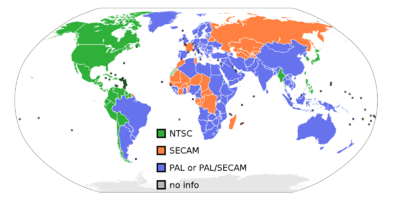List of regional version differences (disambiguation): Difference between revisions
(SSBU regional differences Page is needed) |
mNo edit summary |
||
| Line 2: | Line 2: | ||
:''"Region" redirects here. For geographical areas related to competitive players, see [[:Category:Smash regions]].'' | :''"Region" redirects here. For geographical areas related to competitive players, see [[:Category:Smash regions]].'' | ||
[[File:PAL-NTSC-SECAM.png|thumb|400px|Regions of the world which used the different encoding systems. SECAM is not applicable to the Smash series, and should be assumed as an extension to the PAL region.]] | [[File:PAL-NTSC-SECAM.png|thumb|400px|Regions of the world which used the different encoding systems. SECAM is not applicable to the ''Smash'' series, and should be assumed as an extension to the PAL region.]] | ||
Each game in the [[Super Smash Bros. series|''Super Smash Bros.'' series]] has its own '''list of regional version differences'''. | Each game in the [[Super Smash Bros. series|''Super Smash Bros.'' series]] has its own '''list of regional version differences'''. | ||
| Line 11: | Line 11: | ||
"'''[[PAL]]'''" is a term referring to the region of Europe, Asia (minus Japan), Africa, Australia and some of South America. The term comes from the analog television encoding system '''Phase Alternate Line''', the primary method of encoding analog TV for these parts of the world. PAL is most commonly used as shorthand for "the European version of a game". Historically, Europe is usually the third and final region for games made in Japan to be released, as games have to be translated into several languages, a process that takes both more time and more space than the NTSC region. In addition, due to cultural differences, the English translation cannot always be simply copied from the American version of the game. As a result, PAL releases are often the final version of the game, with all known bugs fixed and possibly significant changes added. | "'''[[PAL]]'''" is a term referring to the region of Europe, Asia (minus Japan), Africa, Australia and some of South America. The term comes from the analog television encoding system '''Phase Alternate Line''', the primary method of encoding analog TV for these parts of the world. PAL is most commonly used as shorthand for "the European version of a game". Historically, Europe is usually the third and final region for games made in Japan to be released, as games have to be translated into several languages, a process that takes both more time and more space than the NTSC region. In addition, due to cultural differences, the English translation cannot always be simply copied from the American version of the game. As a result, PAL releases are often the final version of the game, with all known bugs fixed and possibly significant changes added. | ||
While analog connections are not commonly used in game consoles anymore, with the [[Nintendo Wii]] being Nintendo's last console to support them, the terms "NTSC" and "PAL" are still commonly used to refer to differences between the North American and European versions of any particular game. | |||
* [[List of regional version differences (SSB)]] | * [[List of regional version differences (SSB)]] | ||
Revision as of 03:36, May 4, 2019
- "Region" redirects here. For geographical areas related to competitive players, see Category:Smash regions.
Each game in the Super Smash Bros. series has its own list of regional version differences.
Many games developed in Japan usually see a Japanese release first. These usually have different text, names, sounds, and minor aesthetic changes from the NTSC and PAL versions. The initial Japanese release of the game may naturally come with some initial bugs, and minor to major changes may be seen in future regional releases.
Within the video gaming community, "NTSC" refers to the region of North America and small parts of South America and Asia. The term comes from the analog television encoding system National Television System Committee, the primary method of encoding analog TV for North America, South America, and Japan. NTSC is most commonly used as shorthand for "the North American version of a game". Historically, North America is usually the second region for games made in Japan to be released, as only an English translation is necessary for arguably the most important overseas market. As a result, NTSC releases are often the second version of the game, with major bugs fixed and possibly minor changes added.
"PAL" is a term referring to the region of Europe, Asia (minus Japan), Africa, Australia and some of South America. The term comes from the analog television encoding system Phase Alternate Line, the primary method of encoding analog TV for these parts of the world. PAL is most commonly used as shorthand for "the European version of a game". Historically, Europe is usually the third and final region for games made in Japan to be released, as games have to be translated into several languages, a process that takes both more time and more space than the NTSC region. In addition, due to cultural differences, the English translation cannot always be simply copied from the American version of the game. As a result, PAL releases are often the final version of the game, with all known bugs fixed and possibly significant changes added.
While analog connections are not commonly used in game consoles anymore, with the Nintendo Wii being Nintendo's last console to support them, the terms "NTSC" and "PAL" are still commonly used to refer to differences between the North American and European versions of any particular game.
- List of regional version differences (SSB)
- List of regional version differences (SSBM)
- List of regional version differences (SSBB)
- List of regional version differences (SSB4)
- List of regional version differences (SSBU)

